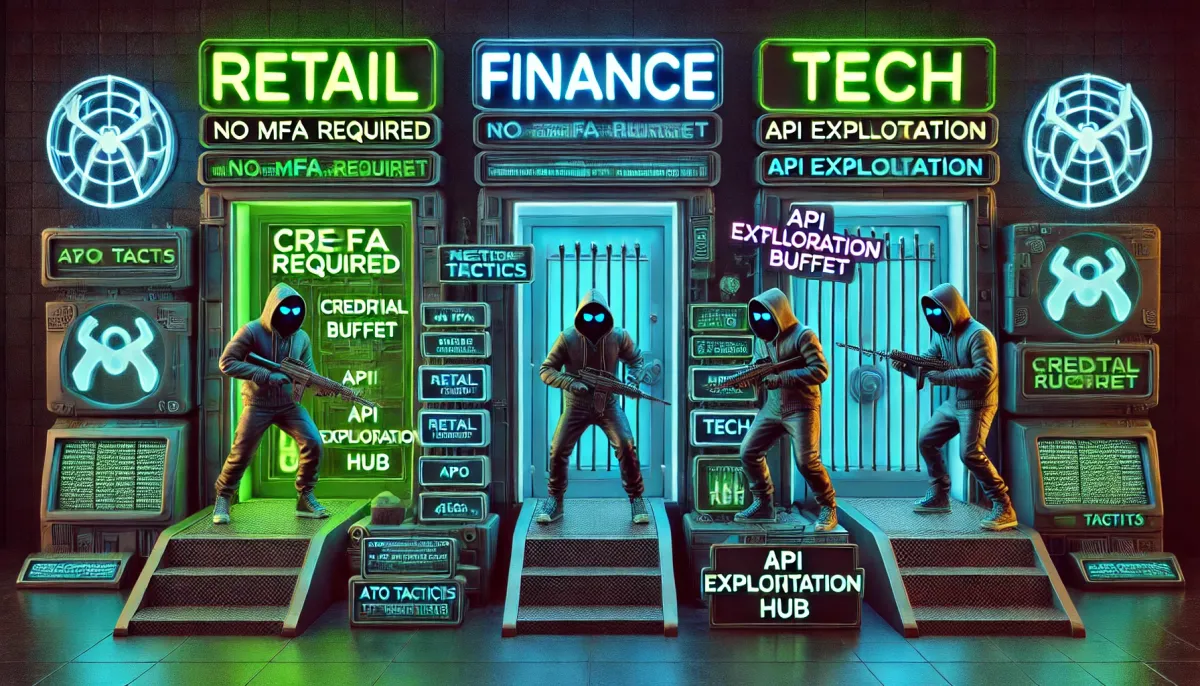Comparative Analysis of Account Takeover (ATO) Attack Vectors Across Financial, Retail, and Technology Sectors
Account Takeover (ATO) attacks pose significant threats across various sectors, leading to financial loss, data breaches, and reputational damage.

EDITOR'S NOTE: Thanks for taking the time to subscribe and read these, if they bring you value, just hit reply and let me know!
TL;DR
Account Takeover (ATO) attacks pose significant threats across various sectors, leading to financial loss, data breaches, and reputational damage. This report provides a comparative analysis of ATO attack vectors in the financial, retail, and technology sectors, highlighting the specific tactics, techniques, and procedures (TTPs) used by threat actors, sector-specific vulnerabilities, and effective mitigation strategies.
- Financial Sector:
- TTPs: Phishing, ransomware, DDoS, credential stuffing.
- Vulnerabilities: Outdated infrastructure, regulatory compliance, external attack surfaces.
- Mitigation Strategies: MFA, continuous monitoring, EASM tools.
- Retail Sector:
- TTPs: Exploitation of e-commerce platforms, phishing, malicious browser extensions.
- Vulnerabilities: Online platforms, customer-facing applications, third-party services.
- Mitigation Strategies: E-commerce security, security audits, customer education.
- Technology Sector:
- TTPs: Advanced phishing, cloud and API exploitation, ransomware.
- Vulnerabilities: New technologies, cloud services, supply chains.
- Mitigation Strategies: API security, cloud monitoring, zero-trust models.
Research
Financial Sector
In the financial sector, ATO attacks are primarily driven by phishing, ransomware, Distributed Denial of Service (DDoS), and credential stuffing. Threat actors employ sophisticated phishing campaigns to deceive employees or customers into revealing login credentials, facilitating unauthorized access. The sector's vulnerabilities include outdated infrastructure, stringent regulatory compliance measures, and a lack of focus on external attack surfaces. The interconnected nature of banking networks means that a single weak link can compromise the entire system. Mitigation strategies include implementing multi-factor authentication (MFA), continuous monitoring of the application layer for behavioral anomalies, and using external attack surface management (EASM) tools.
Retail Sector
The retail sector faces ATO attacks through the exploitation of e-commerce platforms, phishing, and malicious browser extensions. Threat actors target customer accounts to facilitate fraudulent transactions and data theft. High reliance on online platforms and customer-facing applications, inadequate security measures on e-commerce sites, and the use of third-party services increase the risk of ATO attacks. Effective mitigation strategies involve strengthening e-commerce platform security, conducting regular security audits, and educating customers about phishing and other social engineering attacks.
Technology Sector
In the technology sector, advanced phishing techniques, exploitation of cloud environments and APIs, and ransomware are common TTPs. Threat actors often target tech companies' user accounts to access sensitive data and intellectual property. The rapid adoption of new technologies, extensive use of cloud services, and complex supply chains create multiple entry points for attackers. Mitigation strategies include implementing robust API security measures, continuous monitoring of cloud environments, and adopting zero-trust security models.
Breaches and Case Studies
- (2024-05-01) Santander Data Breach:
- Hackers stole data, including 30 million people's bank details, and posted it for sale.
- Actionable Takeaways: Enhance data encryption, implement robust incident response plans, and conduct regular security audits.
- References: CybelAngel
- (2023-11-01) Bank of America Ransomware Attack:
- The Lockbit ransomware group exposed personal information of approximately 57,000 customers.
- Actionable Takeaways: Strengthen third-party vendor security, implement MFA, and conduct regular employee training on cybersecurity.
- References: CybelAngel
- (2024-02-01) Evolve Bank & Trust Data Breach:
- A data breach affected at least 7.6 million people, leading to free credit monitoring and identity theft protection for affected customers.
- Actionable Takeaways: Improve data protection measures, enhance monitoring and detection capabilities, and provide customer support for breach victims.
- References: CybelAngel
Recommendations, Actions, Suggested Pivots, Forecasts and Next Steps..
(Subscribers Only)


![[DEEP RESEARCH] Zero-Days Are a Distraction: 2025’s Biggest Losses Were Stolen Tokens + OAuth](/content/images/size/w600/2025/12/zz-3.png)


